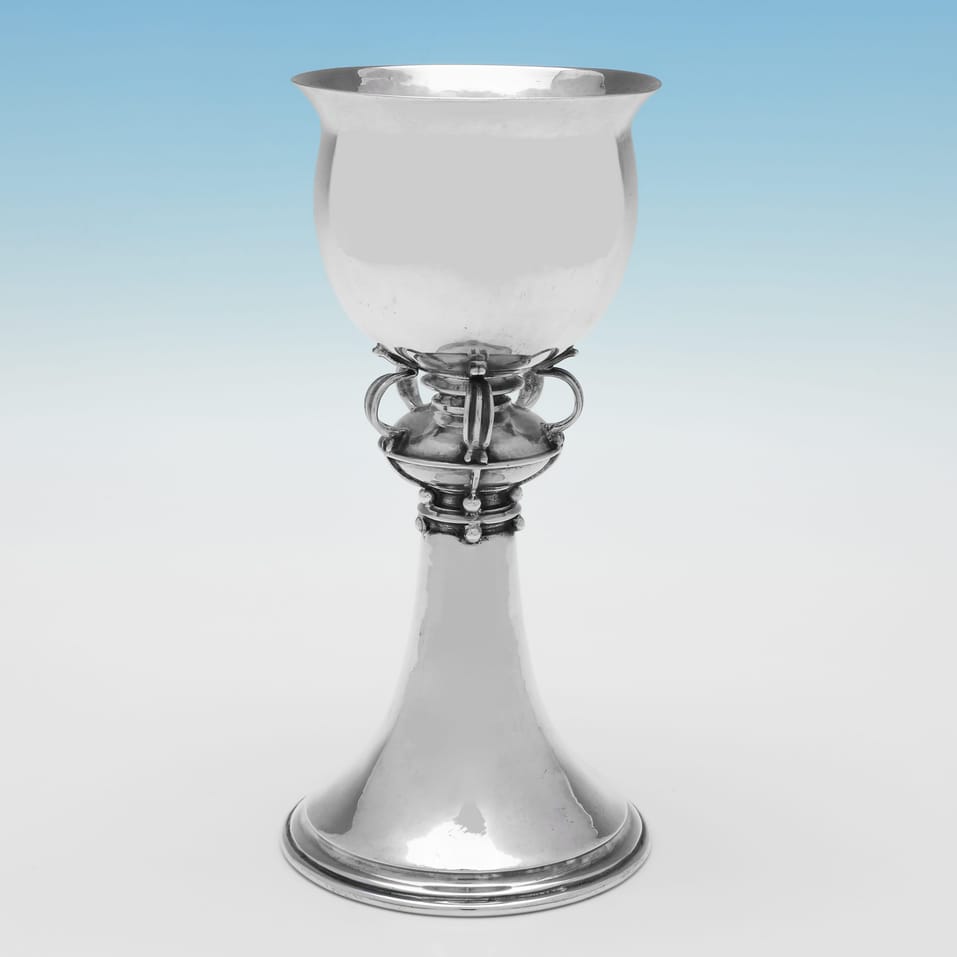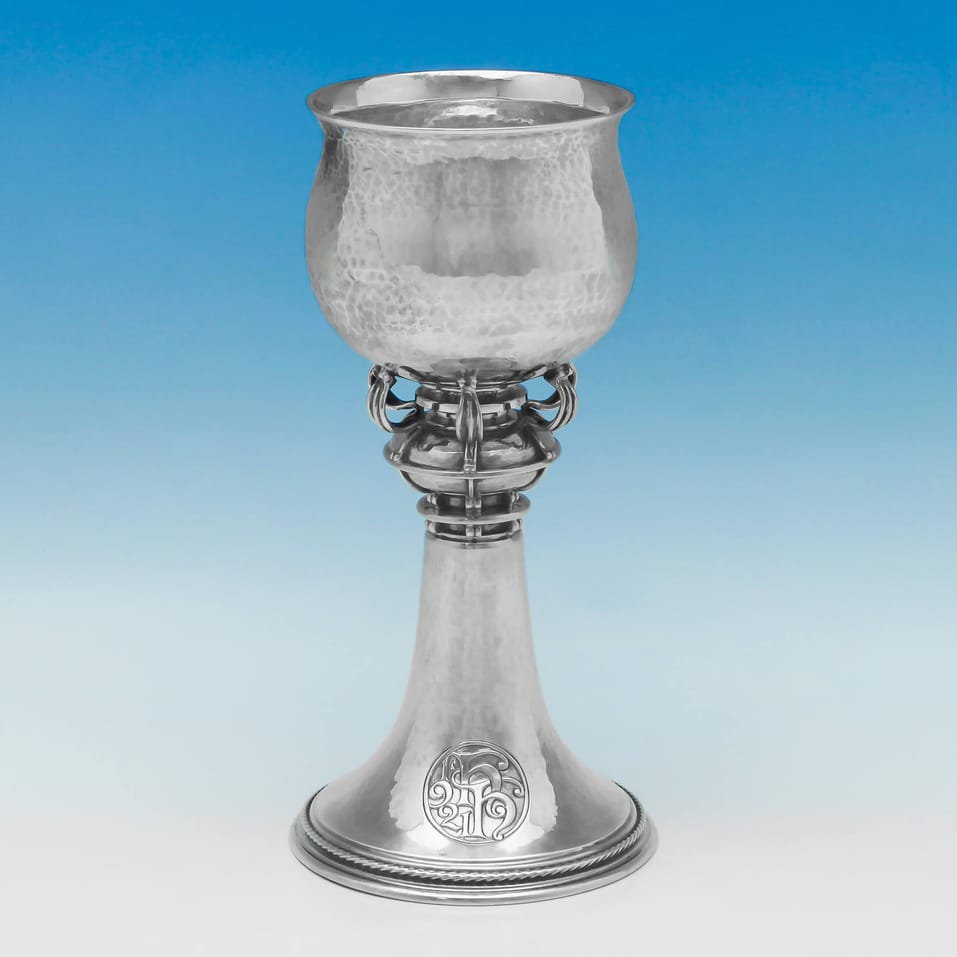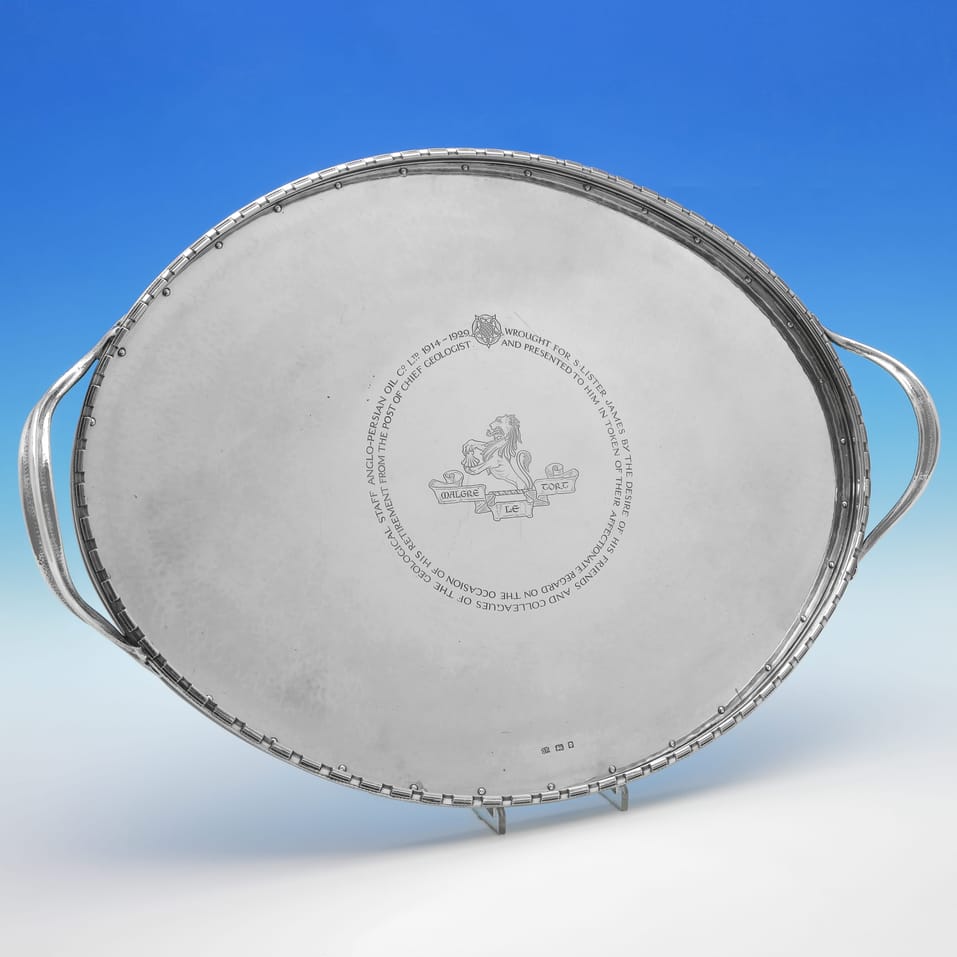OMAR RAMSDEN
Omar Ramsden is one of the most recognised names in silverware of the arts and crafts period in England. The silverware that came from his workshop is highly sought after by collectors, and the pleasing designs that his work often shows has made it popular all over the world. His work displays the perfect blend of modern and traditional styles, and the mystique surrounding him has captivated silver collectors for over 100 years.
Born in Sheffield in 1873, Omar Ramsden (originally Omer on his Birth certificate), was the son of Benjamin Ramsden, a silversmith and engraver who was based at the Rockingham Works in Sheffield. Ramsden spent an early part of his childhood in America, but had returned to England by 1887, when he was apprenticed to an unrecorded firm of silversmiths in Sheffield, learning over the next 3 years the skills and experience needed for the manufacture of different items of silverware. In 1890 Ramsden began attending evening classes at the Sheffield School of Art, at the time considered one of the Worlds foremost schools of art and design, and it was here that he showed an interest in the creative process behind the design of silverware. It was also here that he met Alwyn Carr, a man only a year older than him, and with whom he quickly developed a strong friendship, despite always maintaining a healthy competition.In 1893 Carr was awarded the Sheffield Corporation Scholarship to attend the Sheffield School of Art, and the following year Ramsden was awarded the same accolade. Over the next 3 years the two men worked in a friendly rivalry, attending special courses at the Royal College of Art in London, and visiting museums and sketching the exhibits they saw. When the tenure of Carr’s scholarship ended in 1897, the two friends left England, and spent the next 18 months travelling through Europe, and visiting the many galleries and exhibitions on their journey. The same year that they left England, Ramsden also won first prize in an open competition to design the Mace for the City of Sheffield, and he turned to Carr to help him in its manufacture. There is little doubt that this was the beginning of their partnership, although their joint mark was registered a year later in 1898.On their return to England, Ramsden and Carr set up their first studio together at the Stamford Bridge Studios in Chelsea, London. It was here that the Mace for the City Of Sheffield was manufactured, being completed in 1899. Two other notable pieces of silverware were produced in 1899, a bowl which can be seen in the City Museum of Sheffield, and a tall vase which belongs to a private collection. Both these pieces show a different character from the mace, having more imaginative design, and they show a clear understanding of both the Arts and Crafts movement, and the Art Nouveau form. These pieces can be considered amongst the highest level of craftmanship of silver items produced in this period, and their manufacture elevated the standing of Ramsden and Carr in the public eye. It was these pieces that were to be the precursor for the famous engraving found on Ramsden’s work in later periods ‘Omar Ramsden Me Fecit’ as they were detailed with similar wording ‘Omar Ramsden and Alwyn C. E. Carr made me in the year of our Lord 1899’. The success they garnered from these pieces enabled Ramsden and Carr to purchase new premises, and in 1901 they moved the studio to Albert Studios on Albert Bridge Road in London, at the same time moving their workshop to larger premises in Fulham. In 1904, having not enjoyed working at Albert Studios, they moved to a much finer property in Seymour Place, which they transformed into St Dunstan’s studios. Much of the money they made over the next few years was used to improve both St Dunstan’s and the workshop, the latter of which they increased in size by buying the adjacent yard and constructing new areas for chasers, and a drawing office. The years up until the First World War were very profitable for the partnership, and during this period, in 1907, possibly the finest piece off silverware made by Ramsden and Carr was produced. The Monstrance, commissioned by Westminster Cathedral, was a triumph of design further elevating their standing as master craftsman and bringing in many further commissions from religious foundations. In 1914 at the outbreak of the war, Carr joined the Artists Rifles regiment and left for France, but Ramsden remained in London. On his return after the war they tried to continue the partnership but it proved to be difficult, the two partners having changed and the business having moved on. Their partnership was formally dissolved in 1919, with Ramsden retaining St Dunstan’s and the workshop in Fulham.In the years after the partnership had ended Ramsden continued to thrive as a manufacturer of the finest silverware. The workshop employed many fine silversmiths who worked with Ramsden, including Walter Andrews, Leonard Burt, A. E. Ulyett, William E. Maggs and Leslie Durbin (who was apprenticed to Ramsden in 1929), as well as the enamelers Jeanne Etéve and Henri de Konigh. Possibly the highlight of this period produced at the workshop was the wonderful gold Jewel and Chain commissioned by Lord Rothermere in 1929 for the Company of Master Mariners, but also of note are the striking candlesticks produced for the St Bartholomew the Great church of London (the oldest Church in London, founded in 1123), and commissions for the Honourable Artillery Company. These pieces increased Ramsdens reputation, and the demand for his work increased rapidly over the years. In the mid 1920’s Ramsden married his friend Annie Emily Berrife (formerly Annie Downes-Butcher), who worked with him and was directly responsible for much of the development of the business, and they remained together, at the workshop and at St Dunstan’s, until his death in 1939.
4 results
L0142 : Sterling Silver Arts & Crafts Goblet
Hallmarked In 1917
Hallmarked in London in 1917 by Omar Ramsden, this magnificent, Antique Sterling Silver Goblet, is in the Arts & Crafts style, featuring a hand hammered finish, intricate decoration between the bowl and stem, and is engraved "Omar Ramsden Me Fecit" to the base. The goblet measures 7"(17.5cm) tall, by 3.25"(8.5cm) in diameter and weighs 5.8 troy ounces.
£3,495
L2547 : Sterling Silver Arts & Crafts Goblet
Hallmarked In 1920
Hallmarked in London in 1920 by Omar Ramsden, this rare, very handsome, Sterling Silver Goblet, is in the Arts & Crafts style, featuring a hand hammered finish, rope detailing, and an ornate knop. The goblet is chased with the initials of the original owner (H.H.), and the date 1921, and is engraved “Omar Ramsden Me Fecit” to the base. The goblet measures 7.5"(19cm) tall, by 3.5"(9cm) in diameter and weighs 7.1 troy ounces.
£3,775
L6977 : Sterling Silver Chalice
Hallmarked In 1936
Hallmarked in London in 1936 by Omar Ramsden, this wonderful, Sterling Silver Chalice, is in the Arts & Crafts taste, and features the original gilding and the cast and applied crest of the Royal Horticultural Society. The chalice was given as a gold medal prize at the Chelsea Flower Show of 1937, and is engraved with "In Commemoration of the Accession of King George IV" around the rim, and lower down on the body the engraving reads "Chelsea Flower Show May 26 - 28 1937 - To Hocker Edge Gardens For Their Gold Medal Rock Garden". The chalice measures 7.5"(19cm) tall, by 6"(15cm) in diameter, and weighs 22.7 troy ounces.
£4,975
L7332 : Sterling Silver Tray
Hallmarked In 1929
Hallmarked in London in 1929 by Omar Ramsden, this large George V period, Sterling Silver Presentation Tray, is oval in shape, with a spot hammered finish, and raised gallery with a castellated border. The centre with a presentation inscription and crest and motto of Mr S Lister James. The tray measures 3"(7.5cm) tall, by 27"(68.5cm) wide, by 18.5"(47cm) deep, and weighs an impressive 177.6 troy ounces.
The presentation inscription reads. "Wrought for S. Lister James by the desire of his friends and colleagues of the Geological Staff Anglo-Persian Oil Co. Ltd. 1914-1929, and presented to him in token of their affectionate regard on the occasion of his retirement from the post of Chief Geologist'.
The Anglo-Persian Oil Co. Ltd. was one of the an antecedents of BP.
£14,975



